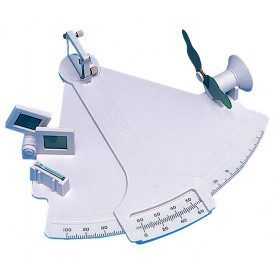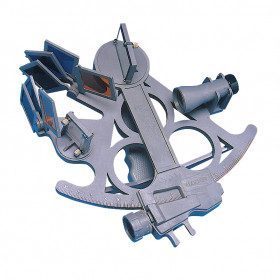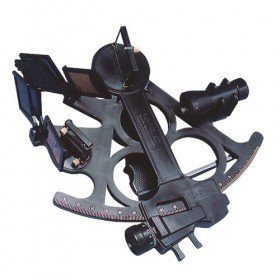
Sextant
The sextant is the result of several centuries of experimentation in which navigators tried out and designed different models for measuring the stars. From a simple stick sliding on an axis, sailors first moved on to the astrolabe, then to the octant and finally at the end of the 18th century the sextant appeared, the most successful instrument for measuring the height of a star, sun or planet.
What is a sextant used for?
The sextant is a device for measuring the height in degrees, minutes and seconds of a star in relation to the horizon. The sun is the most used star because it can be measured all day long but it is also possible to use the moon, the planets and some stars. In this case, the measurements are made at sunrise or sunset in order to visualize the horizon. With this height measured at a very precise moment (to the second), it is possible to determine, by calculation and/or with tables, a line on which one is at this moment. By making 3 simultaneous measurements (stars) or at 3 different times with the sun, we can determine the position on which we are
How to use a sextant
The sextant is one of the components of the work to determine the height line and its position. But it is a determining component because the accuracy of the measurement will depend on the accuracy of the point: for example 1 minute of error in the sextant measurement or one second of shift in the time measurement can cause a shift of 1 mile. It is therefore necessary to be rigorous and precise. To do this, the first task is to adjust the sextant precisely, which must be done on land in order to be able to use landmarks and distant objects. At sea, there are also corrections to be made in relation to the horizon, known as collimation. It is also necessary to ensure that the watch is accurate to the second by setting it to the atomic clock before setting off. For height measurement, the main difficulty on a pleasure boat is to manage to take a measurement with the sextant despite the movements of the boat: it is advisable to do it as close as possible to the mast step or the centre of the boat, as this is the place that "moves" the least on the boat. After making the adjustments and corrections :
- position the necessary light filters according to the intensity of the sunlight and on the horizon.
- place the mobile arm on 0° and the knob on 0'.
- aim the eyepiece or the telescope at the sun, then lower the sun on the horizon by moving the mobile arm forward.
- when the sun is close to the horizon, you must position the lower limb or the upper limb just touching the horizon. In Lower Limb (used most frequently) to know the low point and the lower tangent of the sun, it is useful to swing the sextant from left to right to visualize more easily the low point.
How to choose your sextant
Although based on the same principles, there are several types and models of sextant on the market that can be classified into three families:
Plastic sextant: not very expensive to buy, it has the reputation of being unreliable because the plastic tends to be deformed. The quality of the materials used (mirrors, sighting glasses) is also criticised. However, as a backup in case of power failure, it is perfectly suitable.
Metallic sextant (entry level): it allows reliable and good quality measurements, sufficient in any case for routine or emergency use. The absence of a telescope makes it less "comfortable" to use and certainly less accurate, especially for star and planet measurements.
Metallic sextant (top of the range): quite expensive, it easily allows precise and good quality measurements. The most famous brand is "Freiberger" but in this range, the sextants with the best reputation are the Russian ones.
Read more
There are 3 products.
-
<div class="fiche-txt">
<h2>Davis Mark 3 Initiation Sextant</h2>
<p style="text-align:justify;">Small initiation sextant, made of non-deformable plastic materials. It allows to make a point with a reading of two minutes of arc. Very light, it is made of plastic with simple mechanical parts. This sextant has limited adjustment possibilities, but it will allow you to learn the main principles of astronomical navigation and to use it as an emergency sextant on board your boat.</p>
<h2>Detailed characteristics of the Davis Mark 3 Introductory Sextant:</h2>
</div>
available

-
<div class="fiche-txt">
<h2>Davis Mark 25 Sextant</h2>
<p style="text-align:justify;">This sextant is the reproduction of a real professional sextant. It is made of modern plastics, but it remains undeformable, shockproof and corrosion-proof. Light, robust and precise, this sextant is the essential navigation accessory. The Davis Mark 25 allows you to accurately determine all the points necessary for coastal and astronomical navigation.</p>
<h2>Detailed characteristics of the Davis Mark 15 sextant:</h2>
</div>
available

-
<div class="fiche-txt">
<h2>Sextant Davis Mark 15 from Topoplastic!</h2>
<p>This sextant is the reproduction of a real professional sextant. It is made of modern plastics, but it remains undeformable, shockproof and corrosion-proof. Light, robust and precise, this sextant is an indispensable navigation accessory. The Davis Mark 15 allows you to accurately determine all the points necessary for coastal and astronomical navigation.</p>
<h2>Detailed specifications of the Sextant Davis Mark 15 :</h2>
</div>
available

Showing 1-3 of 3 item(s)




